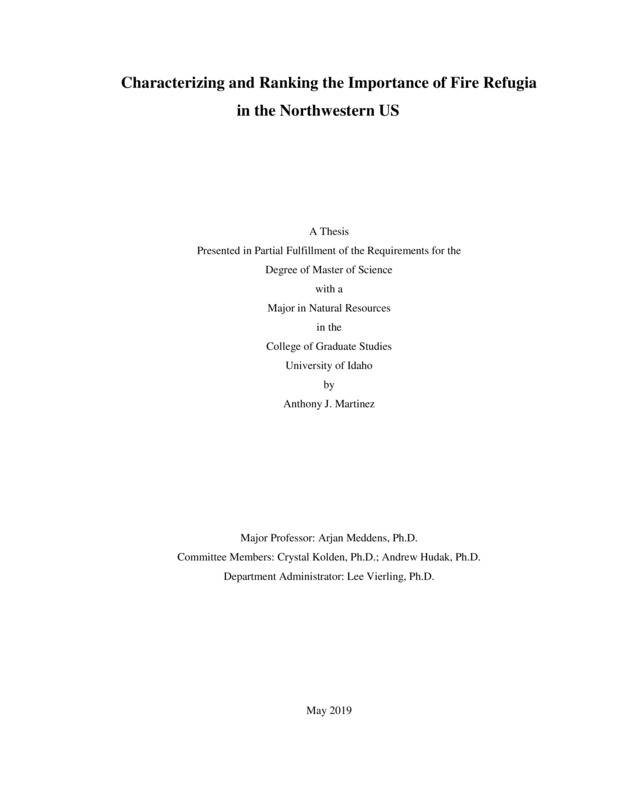Characterizing and Ranking the Importance of Fire Refugia in the Northwestern US
Martinez, Anthony. (2019-05). Characterizing and Ranking the Importance of Fire Refugia in the Northwestern US. Theses and Dissertations Collection, University of Idaho Library Digital Collections. https://www.lib.uidaho.edu/digital/etd/items/martinez_idaho_0089n_11603.html
- Title:
- Characterizing and Ranking the Importance of Fire Refugia in the Northwestern US
- Author:
- Martinez, Anthony
- ORCID:
- 0000-0002-4295-0261
- Date:
- 2019-05
- Embargo Remove Date:
- 2020-07-08
- Keywords:
- fire ecology habitat ranking unburned islands
- Program:
- Natural Resources
- Subject Category:
- Natural resource management; Ecology
- Abstract:
-
Fire refugia are ecologically important features on the landscape. Fire refugia are becoming an increasingly popular topic in the discussion of how to improve forest resiliency in the face of shifting fire regimes. Presently, land managers have not been able to utilize fire refugia in their management plans largely due to the challenges associated with locating and prioritizing them. In this thesis, I aimed to address these knowledge gaps by identifying and characterizing high-value fire refugia in the Pacific Northwest of the United States.
Using an existing database of unburned islands from 1984 to 2014, I identified fire refugia that remain unburned over multiple fires. I sampled points in both these persistent fire refugia and in areas burned by wildfire. At these sample points in both persistent fire refugia and in areas burned by wildfire, I compared several topographical and other geospatial metrics of these groups. The analysis revealed that the biophysical setting underlying persistent unburned islands differs between forests and rangelands, and differs from burned areas.
I then investigated the perceived importance of criteria used to identify high-value fire refugia by surveying land managers within the US Pacific Northwest. Participants scored a predetermined list of criteria by their importance for determining the value of fire refugia. The results indicate that respondents generally organized criteria into two groups: human infrastructure and wildlife habitat. However, there was little consensus among respondents in their scoring of fire refugia importance criteria, suggesting that a single fire refugia ranking model for the entire region is not feasible. More targeted approaches that reduce the scale or scope of the ranking model are required.
Finally, I developed a reduced-scope fire refugia importance ranking model for the northern spotted owl (Strix occidentalis caurina) using a multi-criteria decision analysis framework. I then applied the model to four fires in the East Cascades and compared the patch shape, topography, and forest structure of high importance fire refugia and low importance fire refugia. The research shows that higher ranked refugia tended to have structures that were more characteristic of later successional stage forests than lower ranked refugia.
This thesis provides the basis for the identification of high-value fire refugia, potentially allowing land managers to prioritize high-value fire refugia for restoration activates after a fire. Further research is needed to improve their applicability of reduced-scope and reduced-scale fire refugia ranking models to land management.
- Description:
- masters, M.S., Natural Resources -- University of Idaho - College of Graduate Studies, 2019-05
- Major Professor:
- Meddens, Arjan J.H.
- Committee:
- Kolden, Crystal A.; Hudak, Andrew T.
- Defense Date:
- 2019-05
- Identifier:
- Martinez_idaho_0089N_11603
- Type:
- Text
- Format Original:
- Format:
- application/pdf
- Rights:
- In Copyright - Educational Use Permitted. For more information, please contact University of Idaho Library Special Collections and Archives Department at libspec@uidaho.edu.
- Standardized Rights:
- http://rightsstatements.org/vocab/InC-EDU/1.0/

